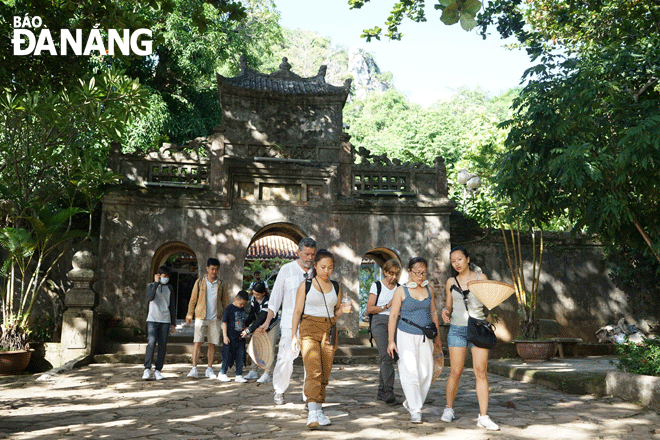Developing the cultural tourism and heritage tourism, or promoting cultural values associated with sustainable tourism development, are important tasks that Da Nang has set in its cultural development plans and strategies in the coming years.
Thanks to a large number of both domestic and foreign tourists, plus a large system of monuments and heritage sites, the city boasts great potential as well as many favourable conditions to pursue and achieve its set targets soon.

International tourists visit the Marble Mountains Tourist Area in August 2022. Photo: Xuan Son
Rich system of relics and cultural heritages
According to the Cultural Heritage Management Office under the Museum of Da Nang, the city is now home to 2 special national-level, 17 national-level and 67 municipal-level relic sites.
In addition, the city has 6 treasures and 6 intangible heritages included in the national heritage list, along with a system of festivals, traditional craft villages, culinary culture, and cultural heritages. All are considered as favorable conditions for the city to develop cultural tourism and heritage tourism.
Under the project on preserving and promoting the value of national cultural heritages in the city for the 2021-2025 period, Da Nang identifies promoting the value of cultural heritages in association with sustainable tourism development as its main task.
Head of the Cultural Heritage Management Office Phan Thi Xuan Mai said that the city is focusing on completing the restoration and embellishment of ranked relic sites, consolidating the management board and making explanations at the relic sites.
In addition, importance is attached to developing tourism with intangible heritages such as ‘Bai Choi’ (singing while acting as playing cards), 'Cau Ngu' (Fish Worshipping) Festival, and Tuy Loan rice paper making village.
In order to exploit and develop cultural tourism, relics must meet the criteria for registration as a destination according to the provisions of the Law on Tourism. In addition to the Marble Mountains Tourist Area that has been recognised as a destination, the city is trying to perfect the infrastructure for 5 relics capable of tourism development. They are An Hai village's Ancestral Church and Thoai Ngoc Hau, K20 revolutionary base, Hoa Vang Martyrs’ Cemetery, relics of Hoa Vang District Party Committee and Thac Gian Communal House.
According to Head of the Management Board of the Marble Mountains Tourist Area Nguyen Van Hien, the Marble Mountains Tourist Area planning project will be submitted to the central government for approval. It is expected that in November 2022, the city will protect its profile before UNESCO to put the Marble Mountains on the list of The UNESCO Memory of the World Committee for Asia and the Pacific. If approved, this will be first world-level heritage site in Da Nang.
Towards sustainable tourism development
In the Prime Minister-approved strategy to develop Viet Nam's cultural industries to 2020, with a vision to 2030, by 2030, revenue of Viet Nam's cultural tourism is expected to make up 15-20% of the US$40 billion in revenue from tourists.
Cultural tourism development is also an important goal in Viet Nam's foreign cultural strategy in the city to 2025 and with a orientation to 2030. In fact, cultural resources are considered as a resource to promote tourism development. At the same time, tourism is also the method and path that many countries are investing in, making the most of the economic factors of cultural values.
Director of the Museum of Da Nang Huynh Dinh Quoc Thien underlined a must-do for localities to organise more unique festivals, and entertainment, sports and community activities, right at relic and heritage sites for both locals and tourists to know and participate in.
According to Director of the municipal Department of Culture and Sports Pham Tan Xu, in recent years, the city has paid great attention to organizing many activities to preserve and promote cultural features, local characteristics and traditions, as well as well exploiting cultural values to serve tourism.
A number of relic sites have become destinations that attract a large number of tourists and are a driving force for socio-economic development for the locality. In addition, the city has formed tours and tourist routes connecting heritage sites and traditional festivals.
In the coming time, the cultural industry will focus on encouraging the development of various types of cultural tourism, especially heritage tourism, spiritual tourism, and tourism associated with traditional and modern festival activities in Viet Nam.
Greater efforts will be made to strengthen the organisation of activities to promote tourism, build a rich and friendly tourism image and brand name. Heed will be on promoting the professionalization and socialization of tourism promotion activities.
Reporting by Xuan Dung - Translating by M.Dung